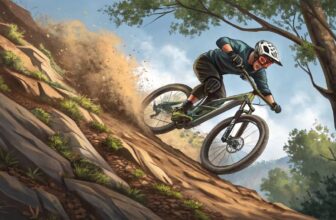Understanding 1x MTB Conversions
Switching up to a 1x drivetrain has taken the mountain biking scene by storm. But what’s the buzz really about? Here, we’ll tackle the slimmed-down weight and the climbing chatter that has folks chatting around campfires or on exhausted climbs.
Weight Considerations
Why ditch extra gears? Simple – shedding some bike pounds. By swapping out the front derailleur and a couple of chainrings, you’re not dragging extra cables and weight on your epic rides. Suddenly, your bike’s not lugging around the bulk that comes with a traditional 2x or 3x setup.
| Component | Traditional 2x Drivetrain | 1x Drivetrain |
|---|---|---|
| Chainrings | 2-3 | 1 |
| Front Derailleur | Yes | No |
| Cables | More | Fewer |
| Total Weight | Heavier | Lighter |
Yet, the actual weight drop can be as small as a few grams, especially if you’re just popping an XT 2x for an XT 1x – we’re talking around 38 grams difference in some setups. Now, if you want a decent weight drop, like 300-400 grams, you might need to empty those pockets and snag high-end parts, which could be a bit weaker too.
On the flip side, simpler bikes can lead to cooler, more innovative frames. You get improvements in frame stiffness and how smoothly the suspension works (BikeRadar).
Climbing Performance Debate
Climbing with a 1x drivetrain has got the community divided. Some say you don’t get the wide range of gears to tackle steep hills easily. A 1x might leave you wishing for that perfect climbing gear combo that 2x offers, keeping the challenge alive on those rugged trails.
| Drivetrain Type | Climbing Gear Options | Gear Range |
|---|---|---|
| 1x Drivetrain | Limited | Narrower |
| 2x Drivetrain | More Varied | Wider |
But hey, lots of riders swear by the simple life. No front derailleur means less stuff to break and smoother shifts, especially when things get tricky on rocky climbs. Less to worry about means more focus on the trail ahead.
Got curiosity piqued by gear ratios and their role in climbing? Check our deep dive on mtb gear ratios.
These thoughts sum up why weight and climbing are such hot topics in the 1x MTB conversion chat. Whether you’re a newbie to mountain biking, a hardcore racer, or just wanting an upgrade, these nuggets of wisdom will guide you. For even juicier info, peep our other reads on mountain bike maintenance, mtb suspension setup, and the best mtb tool kit.
Chain Slap and Chain Management
When switching your mountain bike to a single-ring setup, dealing with chain slap is something you gotta think about. Keeping that chain on the straight and narrow not only makes your ride quieter, it also helps your gear last longer.
Managing Chain Slap
So what’s chain slap? It’s when your chain hits the bike’s chainstay, making noise and possibly dinging up your frame. A single-ring setup often sees less of this because of the trusty derailleur clutch. Still, it ain’t a bad idea to take some extra steps to reduce the hassle.
- Derailleur Clutch: Today’s 1x drivetrains come with derailleurs that have clutch mechanisms to keep that chain snug, cutting down the chances of chain slap. It’s basically chain piggy bank insurance.
- Chainstay Protection: These could be anything from a piece of an old inner tube wrapped around or a proper chainstay protector—it acts like a cushion between your chain and chainstay, keeping things quiet and saving your frame from scrapes.
- Narrow-Wide Chainrings: When it comes to 1x chainrings, they’ve got this wild tooth pattern where skinny and fat teeth alternate to really grip the chain, helping keep chain slap to a minimum.
Chain Retention Accessories
If you’re a daredevil on rocky trails, there are extra goodies you can add to keep the chain behaving like it should.
- Chain Guides: These babies make sure the chain doesn’t jump ship, especially when you’re putting the pedal to the metal.
Chain Guide Type Benefits Top-Only Guides Light, less fuss, good for decent trails Lower Roller Guides Extra hold for the bumpier paths Full Cage Ultimate hold for when it’s all about the downhill - Chain Retainers: This simple gadget, also called a chain catcher, helps your chain stay put, really handy if you’re biking through mud or rocky landscape.
- Bash Guards: These things protect your chainring from any hard hits, while also helping with chain stability. A real buddy for those who love dancing with rocks and such on the trail.
Taking care of your chain properly is a big part of mountain bike upkeep and does a lot for your bike’s drivetrain performance. Curious for more tips on babying your bike? Check out our write-ups on mtb chain TLC and mtb gear matching.
Try out these tricks and tap into the right gear, so chain slap doesn’t ruin your ride mojo. And hey, for those keen on homebrewed bike hacks, our guide’s got your back too!
Lateral Friction Issues
Lateral Friction Concerns
Alright, let’s talk shop about a pretty common gripe folks have with the 1x MTB conversion—lateral friction. You see, lateral friction is that pesky problem that crops up when your bike’s chain has to stretch and reach through a bigger range of gears. Basically, it’s like asking a small kid to do a big kid’s job. In a 1x drivetrain, that chain’s gotta hustle across 11 to 13 gears, compared to a 2x setup where it’s just loafing across about 7 per ring.
Now, why is this important? Well, with a 2x, you get smoother shifts and it can make those uphill slogs feel less like climbing Mt. Everest. The chain doesn’t have to move as much, so there’s less friction slowing you down. If you’re after more on keeping your ride’s shifting buttery smooth, check out our deep dive on mtb gear ratios.
Efficiency Comparison
Thinking about jumping on the 1x conversion train? Hold your horses for a second. It’s a good idea to weigh how much you’ll gain in efficiency versus what you might lose in weight savings. While trimming down on your bike’s heft sounds great, the reality might not blow your socks off. For instance, switching from a Shimano XT 2x to a 1x gives you a measly 38-gram weight drop. Shell out some serious dough, and maybe you’ll shed 300-400 grams, but your wallet’s gonna feel it too.
| Conversion Type | Weight Savings (grams) | Estimated Cost ($) |
|---|---|---|
| Shimano XT 2x to 1x | 38 | ~200 |
| Top-level 2x to 1x | 300-400 | 1500+ |
There’s a plus, though. 1x systems cut down on chain noise thanks to the derailleur clutch. But hey, you don’t need to toss out the 2x yet—just wrap an old tube around your chainstay for a cheap fix. And if you’re really worried about the chain lifting off, there are gadgets out there to help keep it right where it belongs. Peep our mtb chain maintenance tips for more chain care tricks.
For more than just scratching the surface on this drivetrain stuff, check out MTB drivetrain compatibility for some real down-and-dirty knowledge. Getting a grip on these finer details can go a long way toward making savvy decisions about 1x MTB conversions and tackling those sneaky lateral friction gremlins.
Top-End Speed and Gear Range
Impact on Top-End Speed
When considering a 1x MTB conversion, one major factor is how it affects your top speed. With just one chainring upfront, you’re somewhat capped compared to the multiple gear options of 2x or 3x setups. This could leave speed demons wanting more, especially on flat terrains or when racing downhill. Some bikers have found themselves out of gears when trying to crank up the speed with a 1x system.
Gear Limitations
By ditching the front derailleur and sticking to a single chainring, a 1x drivetrain simplifies your ride, trims down weight, and lets you focus on the thrill of the trail.
But, it narrows your gear choices, which might be a bummer during steep uphill battles or rapid descents where you’d usually want more options. To counteract this, gravel and mountain bikes often sport a wide cassette, sometimes boasting up to 13 gears.
| Drivetrain | Chainrings | Sprocket Range | Speed Potential |
|---|---|---|---|
| 1x | 1 | 7 – 13 | Moderate |
| 2x | 2 | 9 – 12 | High |
| 3x | 3 | 9 – 12 | Very High |
A 1x may keep things straightforward and shed some weight, but riders must balance these perks against the possible dip in speed and gear variety. Speedsters might find a 2x setup more fitting. For deeper dives into gear choices, check our MTB gear ratios guide.
Switching to a 1x drivetrain could mean a personalized ride that’s tailored to your kind of trail or style. If you’re aiming for that sweet spot between simplicity and performance, it pays to explore different setups and know what they bring to the table. And don’t forget to peek at our mountain bike maintenance tips to keep your ride in top gear.
Evolution of 1x Drivetrains
Introduction of SRAM’s XX1
In mountain biking, SRAM shook things up back in 2012 with their XX1 groupset. They weren’t messing around, marking a big win for 1x (one-by) drivetrains. Thanks to SRAM, bikers could say goodbye to fumbling through multiple gear rings. This XX1 groupset brought everyone a leaner, meaner way to cruise the trails.
Here’s the deal with the SRAM XX1: it shifted to a 1×11 setup, ditching that bulky front derailleur. One chainring, and eleven gears—an easy-breezy combo that kept things light. This innovation inspired other brands to hop on the 1x train, each tweaking their versions to suit all types of riders.
Advantages of 1x Drivetrains
1. Simplified Gear Shifting
A big plus for 1x drivetrains is how they take the hassle out of gear shifting. With just one chainring at the front, bikers can forget about juggling between multiple ones, which comes in handy when tackling tricky trails. This setup means there’s just one gear lever, so you can tune out the gear fuss and tune into your ride.
2. Weight Savings
Strip down a mountain bike by losing the front derailleur, some extra chainrings, and cables, and you’ve got yourself a lighter rig. 1x drivetrains trim the fat, so to speak. It’s not just about bragging rights on weight, either. Shedding those grams helps when you’re peddling uphill or weaving through gnarly paths (BikeRadar).
3. Frame Design Flexibility
No front derailleur means designers can get creative with bike frames. The freedom allows tweaking for stiffer frames and better suspension setup. This translates to a bike that’s more responsive and performs better, making biking feel smooth and controlled.
4. Reduced Chain Drop
No one likes a slipped chain in the middle of a ride, right? 1x drivetrains tackle this with narrow-wide chainrings, boosting chain retention. For those who like to test gravity’s limits, you can always add more chain protection for a safety net during those daring descents. Check out ways to secure your chain.
| Advantages | 1x Drivetrains |
|---|---|
| Simplified Gear Shifting | Cuts out the fuss of front chainrings |
| Weight Savings | Gets lighter by tossing extra gear junk |
| Frame Design Flexibility | Promotes rigid frames and better suspension |
| Reduced Chain Drop | Narrow-wide rings and extra chain safeguards |
All these perks mean 1x drivetrains hook in riders, whether you’re buying your first bike or sprucing up your trusty old one. The ease of use, lightness, and boost in performance of a 1x setup can really ramp up your biking adventures. Looking for more info on what fits where? Swing by our page on mtb drivetrain compatibility for a closer look.
Converting to a 1x Drivetrain
Leaping from a traditional multi-gear system to a straightforward 1x drivetrain is a smart move for mountain bikers craving a simpler, lighter ride with a performance edge.
Dedicated Groupset vs. Adaptation
When it comes to switching to a 1x setup, you’ve mainly got two choices: go all-in with a sleek new 1x groupset or tweak what you’ve already got.
Dedicated Groupset: This all-in-one package is custom-made for the 1x life. We’re talking a single chainring, a rear derailleur, a cassette, and maybe even a tailored shifter. The biggest win here? Everything fits together like PB&J, giving you top-notch performance and peace of mind.
Adaptation: More of a DIY approach, this involves reshaping your current ride:
- Wave goodbye to that front derailleur and shifter
- Slap on a narrow-wide chainring to keep that chain in check
- Consider adding a clutch rear derailleur or a chain guide to stop any chain escape acts
Comparative Table:
| Option | What You Get | Chain Security | Cost | Fit | Install |
|---|---|---|---|---|---|
| Dedicated Groupset | Full package | Optimized | Mega Bucks | Top-notch | Breezy |
| Adaptation | Mix and match parts | Needs Extras | Budget | Mixed Bag | Doable |
Components for Conversion Process
Whichever path you choose—fancy groupset or handy adaptation—there are some key components you’ll need for your 1x transformation:
- Single Chainring: Think narrow-wide here to keep that chain snug.
- Clutch Rear Derailleur: The clutch helps keep the chain in line, reducing annoying slaps.
- Cassette: Pick a wide-range cassette that jives with your bike to ensure your gear range stays awesome.
- Chain Guide (if you like): For extra stability over bumpy ground, a chain guide is your friend.
Components Table:
| What You Need | What It Does | Why You Need It |
|---|---|---|
| Single Chainring | Narrow-wide design | Holds chain tight |
| Clutch Rear Derailleur | Keeps chain tension high | Less chain slap |
| Wide-range Cassette | Offers lots of gear options | Keeps you in range |
| Chain Guide (Optional) | Keeps chain steady | Chain protection |
While converting, check the chain length so everything runs smoothly. For tips on nailing this, see our mtb chain maintenance guide—it’s a lifesaver.
And don’t forget: double-check mtb drivetrain compatibility before shelling out for new parts. It’ll save you tears later.
For the hands-on type who likes rolling up their sleeves with diy mountain bike repairs, doing a 1x conversion is a cool project. Plus, it gives you the chance to tailor your bike to match your style and trails. Need help keeping your beast in shape? Hit up our mountain bike maintenance resources.
Switching to a 1x drivetrain might sound like a puzzle, but it’s a breeze once you dive in. Choose what suits your wallet, riding vibe, and know-how to make the most of your new setup.
Front Shifting Optimization
If you’re looking to get the most out of your mountain bike’s gear shifting, check out the SRAM RED AXS front derailleur. The features of this top-notch piece of kit, along with tips for setting it upright, are definitely worth your attention. Dive into the details of what makes this component a standout.
RED AXS Front Derailleur Features
The SRAM RED AXS front derailleur is crafted to up your game when it comes to smooth gear switching. Here’s what makes it special:
- Refined Cage Shape: This cage is designed to sneak past the chain, with no extra fuss, making shifting gears feel like a dream.
- Auto Trim Feature: Automatically keeps things in line, so you don’t have to worry about your gears not hitting the sweet spot.
The refined cage practically glides through, making precise shifting a breeze, while the auto trim feature steps in to prevent any hiccups during your ride.
Setup for Top-Notch Shifting
To max out the performance of your SRAM RED AXS front derailleur, here’s how you get it all lined up:
- Position Just Right: Set that derailleur at the right height and angle by the chainring. It’s all about keeping everything in harmony for a seamless ride.
- Tension Tune-Up: Dial in that cable tension ’til it’s just right. Too tight or too loose, and you’ll be grinding gears like a newbie.
- Hit That Auto Trim: Let the auto trim do its job, especially when your chain’s off-angle. This is where regular derailleurs might get left in the dust.
- Check Your Chain Line: Make sure the chain isn’t doing any extra work; it should flow nicely and easily. Peek at our mtb drivetrain compatibility guide for more on this.
- Micro Adjust Magic: Tweak it all snug using the MicroAdjust function. Fine-tuning is the name of the game for top gear performance.
| Setup Step | Key Move | What You Get |
|---|---|---|
| Position Just Right | Mount properly | Alignment perfection |
| Tension Tune-Up | Set the cable tension | Smooth ride, fewer repairs |
| Hit That Auto Trim | Switch it on | Keeps things in check |
| Check Your Chain Line | Ensure it fits | Easier ride, less friction |
| Micro Adjust Magic | Tweak as needed | Accurate gear changes |
By nailing these setup steps and using the SRAM RED AXS derailleur’s smart features, you’ll feel a noticeable boost in your bike’s gear shifting. For more tips on keeping your bike’s guts in tip-top shape, don’t miss our guides on mtb chain maintenance and mountain bike maintenance.
Dig into our other resources to crank up your mountain biking game with guides on MTB gear ratios and mountain bike brakes comparison. Keep your bike in top condition, and you’ll be tackling those trails like a pro.
Maintenance Tips and Recommendations
Correct Chain Length in 1x Systems
Gettin’ the chain length right on your 1x setup is like striking gold for smooth riding and slick shifting. To nail it, first thread that chain through your drivetrain and get the ends close under the rear derailleur. When they start to meet, slap on two inner and two outer links. This little trick keeps your upper pulley behaving nicely, making sure your shifts are smooth as butter.
You’ll want to check out our mountain bike chain cheat sheet for more juicy details.
MicroAdjust Feature and Brake Pads
MicroAdjust Feature
Here’s where the magic happens. The MicroAdjust feature is like having a secret weapon for your rear derailleur. With teeny adjustments of 0.25 mm, you’re in charge of super-crisp gear changes. Dial this in using the AXS App’s Drivetrain Settings or go old school by holding the shifter’s AXS button while you nudge the shift paddle.
You’ll extend the life of your drivetrain and keep your gears humming along. For more DIY derailleur wisdom, swing by our bike care zone.
Brake Pads
Choosing the right brake pads deserves a drumroll:
- Organic Pads: If you crave peace and ninja-like performance, these are your match.
- Sintered Pads: Got weather? These are tough cookies and won’t back down from a storm.
New pads? Don’t forget the bed-in dance. Gradually ramp up brake power to get them singing sweetly and minimize squealing. For a showdown of different brake types and upkeep tips, peep our brake showdown.
| Brake Pad Type | Conditions They Love | Why They Rock |
|---|---|---|
| Organic | Most settings | Quiet, slick moves |
| Sintered | All-weather champs | Tough, reliable |
Keeping your brake pads and drivetrain shipshape is like strapping a rocket to your ride, whether you’re chasing gold medals or just out for a wild weekend. Dip into mountain biking secrets and hands-on bike fixes for more nuggets of wisdom.
Mullet Mountain Bike Configurations
Common Mullet Setup Features
Let’s chat about mullet mountain bikes. Don’t worry, this isn’t about questionable hairstyles. A mullet setup pretty much involves sticking a big wheel at the front and a smaller one at the back. Why, you ask? Well, it makes your ride steady as a rock up front while keeping it zippy at the back when you’re tearing down the trails.
| Feature | Description |
|---|---|
| Front Wheel | 29″ |
| Rear Wheel | 27.5″ |
| Stability | Big wheel up front keeps you steady |
| Playfulness | The big wheel up front keeps you steady |
- What’s the big deal about the 29” front and 27.5” rear wheel? It’s like the best of both worlds – you get the steadiness from the big guy at the front and quick turns from the little dude in the back (The Lost Co.).
- Got a bike with two big wheels and thinking of making it a mullet? Swapping the back one for a smaller wheel means you’ll feel like a superhero during those wild downhills.
Manufacturers’ Mullet Options
Loads of bike makers are getting in on the mullet action. They’re rolling out bikes ready to hit the trails with these mixed wheels, giving riders something a bit different and a whole lot of fun.
- Many bikes these days already come with 29” in the front and 27.5” in the back, cause folks to love a ride that adapts and feels just right.
- Some brands even let you tweak the setup with stuff like adjustable bits, so you can switch your rear wheel size without missing a beat.
Want to make sure your bike fits just right? Check out our lowdown on mountain bike sizing. And if you’re curious about getting your bike gears in tune for a style that suits you, take a peek at our piece on MTB gear ratios.




